#Aelius Lamia
Explore tagged Tumblr posts
Text
trial of Aulus Gabinius
date: 54 BCE, postulatio by Sept. 20; nominis delatio Sept. 28; verdict reached on Oct. 23 charge: lex Cornelia de maiestate (restoration of Ptolemy contrary to SC) defendant: A. Gabinius cos. 58 advocate?: M. Calidius pr. 57 prosecutor: L. Cornelius Lentulus (Cruscellio?) pr. 44 praetor: C. Alfius Flavus jurors: L. Aelius Lamia pr. 42? Cn. Domitius Calvinus cos. 53, 40 (voted A)3 C. Porcius Cato tr. pl. 56, pr. 55 witness: M. Tullius Cicero cos. 63 (Crawford, Orations 64) other: praevaricatio suspected
Cic. Att. 4.18.1; Q. fr. 2.12.2, 3.1.15 and 24; 3.2.3, 3.3.3, 3.4.1-3, 3.7.1; App. BCiv. 2.24; Dio 39.55.3-5, 62.3; Schol. Bob. 168St
35 notes
·
View notes
Text
google how lucius aelius lamia praetor 43 died btw.
11 notes
·
View notes
Text

By: Andrew Doyle
Published: Jan 8, 2023
Stop me if you’ve heard this one. A man’s wife divorces him and shacks up with his boss. Soon after, a friend suggests that he should remarry. “What for?” he asks. “Are you looking for a wife as well?”
It may not be the funniest joke, but that’s because it’s an anecdote from The Lives of the Caesars by the Ancient Roman historian Suetonius. The comedian in this case was a senator called Aelius Lamia whose wife had left him for the Emperor Domitian. For making this casual quip, Domitian had Lamia put to death. Now that’s a bad review.
It might be worth keeping this anecdote in mind when the usual debates flare up about whether comedy “goes too far”. The notion of people being offended by jokes is as old as comedy itself, and often people react angrily if humour isn’t to their taste. The current manifestation of this age-old debate takes the form of a simple dichotomy: “woke comedy” versus “anti-woke comedy”.
Already we are in treacherous waters. It is very unwise to define whole genres by terms that have no settled definitions. The actor Kathy Burke believes that “woke” simply refers to people who are neither racist nor homophobic, which would surely mean that the overwhelming majority of us would happily embrace the term. But for those who have been on the receiving end of the bullying, harassment and intimidation by activists who self-define as “woke”, it is clear this issue is not so straightforward.
Over the past few years, we have seen the emergence of a new comedy movement, one branded by commentators as “anti-woke”, that seeks to push back against the orthodoxies of our time. Its closest historical precedent is the “alternative” comedians of the Eighties, who also took aim at establishment norms and were often similarly blunt in their approach. The key difference today is that there is no broad agreement about where the power in society lies, and so while “anti-woke” comedians see themselves as anti-establishment, their critics insist that the opposite is true.
Consider the example of Ricky Gervais, whose new Netflix stand-up special Armageddon has sparked this most recent round of discussions about the supposed red lines in comedy. Some have accused Gervais of taking a reactionary stance, most notably because of jokes relating to migrants and disabled children. Gervais has been branded an “anti-woke” comedian, but I doubt very much that he would see it in such reductive terms. Anyone familiar with his work will know that he has always lampooned closed systems of thought, and it just so happens that “wokeness” currently represents the dominant incarnation. There was a time when many of Gervais’s critics were perfectly happy to see him take a wrecking ball to the certainties of religious faith. It would appear they take a different view when it’s their own belief system taking a battering.
A simplistic reading of “woke” versus “anti-woke” comedy is that the former “punches up” while the latter “punches down”, but such rules are incoherent when applied to an inherently anarchic medium. Besides, it simply is not true that there exists a growing number of comedians who are seeking fame and easy laughs by taking aim at the most marginalised in society.
As I have said, it comes down to a question of how one perceives power. Too often the culture war is misconceived as a conflict between Left and Right, with “woke” aligned with the former and “anti-woke” with the latter, but “wokeness” carries with it the kind of clout that transcends the political binary. In their 13 years of government, the Conservatives have presided over the worst excesses of this identity-obsessed ideology and the havoc it has wrought on society. Far from fighting a “war on woke”, they have been actively enabling it.
So where does the real power lie? Is it with governments that can be voted out if the public tires of them? Or is it with activists who now have significant influence in all cultural, educational, political and corporate institutions, and who cannot be dislodged by means of any democratic process? These are the same zealots who have fostered racial division in the name of “anti-racism”, jeopardised the rights of women and gay people through the promotion of gender identity ideology, destabilised the very notion of empirical truth, attempted to rewrite our history and reconstruct our culture, and launched a relentless assault on free speech and the achievements of social liberalism. Just because they describe themselves as being “on the right side of history” doesn’t make it true.
And so, when we read an article in the New Statesman lamenting the “tedious world of anti-woke comedy”, we can be fairly sure that the criticism is political. Does the writer sincerely believe that these performers are simply trying to attack minorities and cause as much offence as possible? This is the least generous of all suppositions, one born out of a fundamental misunderstanding of the art of comedy. It strikes me that many of those who dismiss stand-ups as “anti-woke” are simply berating them for taking an anti-establishment stance and for believing that those in power ought to be ridiculed rather than eulogised. But what is the point of a court jester who acts as a propagandist for the king?
Another common reaction from critics has been to imply that certain topics ought to be ring-fenced, and that joking about them is tantamount to a form of violence. The charity Scope has lambasted Gervais’s new show for containing “ableist slurs” and claimed that “language like this has very real consequences”. But those of us who have seen Armageddon would have to concede that the most obvious consequence appears to be the laughter of audience members who are clearly enjoying themselves. What Gervais’s critics mean is that jokes are like toxins, and that popular culture — if not carefully regulated — has the power to corrupt the Great Unwashed. Mary Whitehouse made the identical argument many decades ago.
Fortunately, her fears were unfounded. Over half a century of research into “media effects” theory — the hypothesis that the public will modify its behaviour according to the mass media it consumes — has seen it roundly discredited. Jokes do not cause violence, unless you are talking about Will Smith slapping Chris Rock at the Oscars, or the Emperor Domitian lopping off the occasional head.
The history of comedy shows us that its practitioners will always cause offence, so why do we continue to squabble over where the red lines ought to be drawn? No matter how many times you shift the boundary, it will still end up being crossed. I am not implying here that there is anything wrong with criticism, however puritanical it might be. Comedians who violate popular sensibilities have always faced pushback and resentment. The problem arises when the offended parties seek to impose their tastes on everyone else. So while I support anyone’s right to criticise Gervais’s show, I am disturbed by those who have called on Netflix to censor the offending material.
Personally, I have always relished those comedians who have no clear affiliations, who take aim in all directions and unsettle as much as they entertain. But today’s comedy industry is not a hospitable environment for these sorts of freethinkers. For some years now, there has been an undeniable strain of groupthink among those in positions of power: promoters, commissioners, critics and even some performers. Acts who conform have been rewarded, while those who refuse to do so have been shunned. It hasn’t taken much for up-and-coming comics to realise that it is more profitable to be seen to convey the “correct” message rather than to develop their craft in innovative and individual ways. The impulse to serve Mammon rather than the Muses has enervated the comedy scene, and self-censorship is now the norm.
The writer Graham Linehan is living proof of how heretics are treated in the current climate. For blaspheming against the holy creed of gender identity ideology — one embraced wholesale by the gatekeepers of the comedy industry — he has been unable to work for six years. In his new memoir, Tough Crowd, he discusses how his musical adaptation of Father Ted has been scotched, either because the bosses at Hat Trick Productions (which owns the rights) are too cowardly to be seen promoting his work, or because activist elements within the company disapprove of his views.
Only a couple of decades ago, it was virtually unheard of for comedy promoters to take seriously complaints from audience members claiming to be “offended”. Now, it takes little more than a few disgruntled tweets for venues to panic and cancel bookings. But the backlash is palpable. Many of us have grown weary of comedians toeing the establishment line and substituting agitprop for jokes. Some “anti-woke” comedy may lack sophistication and subtlety, but maybe that’s a small price to pay to redress the balance and reenergise the art form. If you want to smash taboos, sometimes you need a sledgehammer.
==
Social constructivists believe that language doesn't describe reality, it creates reality. That's why they get so angry when anyone blasphemes against their authoritarian ideology. It's like casting a counter-spell which undermines the parallel universe they've conjured.
The people complaining about Ricky Gervais' comedy have nothing to say about the other 95% of his performance.
We have to ignore them.
#Andrew Doyle#Ricky Gervais#comedy#woke#anti woke#wokeness as religion#wokeism#cult of woke#wokeness#woke activism#punching up#punching down#media effects theory#media effects#censorship#offense culture#religion is a mental illness
5 notes
·
View notes
Note
I don’t remember if I’ve asked or if you’ve answered but could you do some soft vampire prince (masc/neutral) names please?
under the cut!
Acacius / Achaikos Aelius Agathon Agnar / Agnarr Alex / Alexander / Alexi Alfie / Alfred Allister Ansgar Archie Atticus Bowie Crown Devan / Deven / Devon Drace / Draco Ewald Ezra Fang Festus James Lami Lamia Louis Luca / Lucas Nik Oakley Oscar Oswald Otto Ozzy Prince Quince / Quincely Romeo Rowen Silas Theo / Theodore Tobias Vamp Vampir / Vampyr Verdan Vinnie / Vincent Wraith
59 notes
·
View notes
Photo

Augustus. 27 BC-AD 14. Æ Dupondius. Rome mint. Q. Aelius Lamia, moneyer. Struck 18 BC. Legend in three lines within wreath / Legend around large S C. RIC I 324; BMCRE 176; BN 236.
0 notes
Text
Lamia the courtesan
A longstanding joke makes a word play between Lamia the monster and Lamia of Athens, the notorious hetaira courtesan who captivated Demetrius Poliorcetes (d. 283 BC). The double-entendre sarcasm was uttered by Demetrius's father, among others. The same joke was used in theatrical Greek comedy. The word play is also seen as being employed in Horace's Odes, to banter Lucius Aelius Lamia the praetor. File Under: Old Jokes
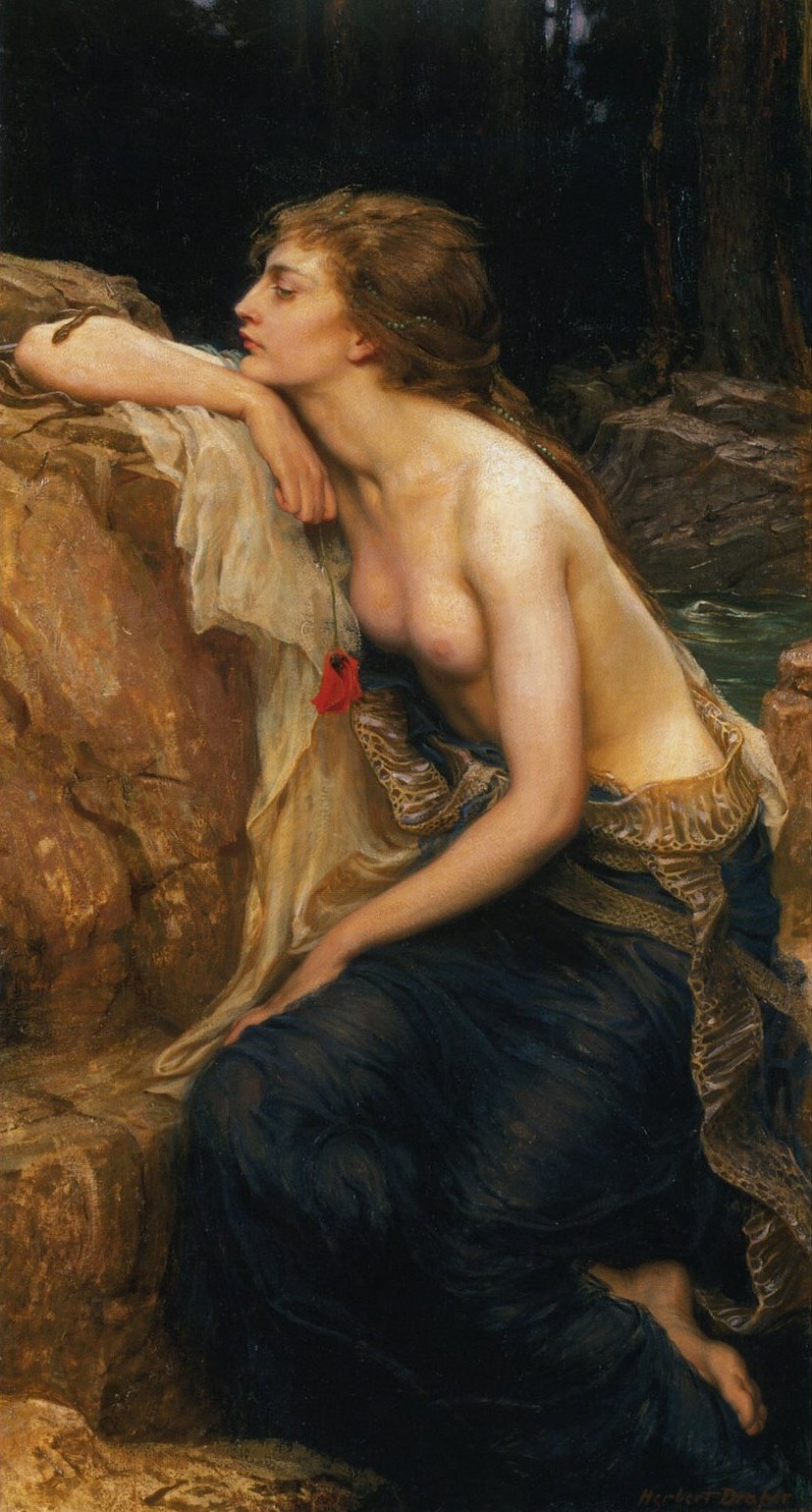
Lamia by Herbert James Draper (1909)
3K notes
·
View notes
Text
Character pronouns
Nature: all pronouns except masc ones
Mika: she/her
Strangleroot: she/her
Blackheart: she/her
Mitsuki: he/they
Cora: she/her
Kiwigash: she/her (doesn't mind though :))
Queenie: she/her
Agnus: she/her (but she's a baby)
Nimue: she/her
Pandora: she/they
Lamia: she/they
Death: he/it
Styx: she/it
Lyra: she/her
Lady of the moon/Lavena: she/her
Man of the sun/Aelius: he/him
Fate: she/they
Time: its/its
Qhirema: She/her
Nepho: they/then fem terms
God of chaos/Maurin: all pronouns
Somnius/god of dreams: all pronouns
Lucy: she/her
Kieptiel: they/she
Angel: she/her
Pixiedust: she/her
Ellie: she/her or any prns
Orchid: she/her
Monika: she/her
James: he/him
Angelina: she/her
Calida: she/her
Astera: she/her
Jasmin: She/they/it
Moss: she/her
XE-17: it/he/she
Silma: it/she
Teeth: he/it
Elizabeth: she/her
Queen Alice: she/her
Emris: she/her
Bunny: she/they
Aisling: she/her
~Møther~: she/it
SiStEr: she/her
PəÞął: it/she
Dakari: he/him
Leo: he/him
Amun: she/they
Amunet: she/her
Bastet: she/her
Appel: she/her
Melanie: she/her
Ash: they/she/it
Checkmace: she/her
Rattlesnake: she/her
Bernadette: she/her
Honey: she/her
Alison: she/it
Kobold: he/him
Auburn: she/her
Sarah: she/her
Cherry: she/her
Silvertongue: she/they
Ruin: they/them
Moira: she/her
Anastasia: she/her
Isaac: he/him fem or neutral terms
Appel: she/her
Mariana: she/her
Sasha: she/her
Yevgeny: he/him
Nicolai: he/him
Alice: she/her
Ink: they/zem fem and neutral terms
Ophie: they/void. Fem, neutral terms
Iru: They/them
Zen: do not percieve/they. Masc terms
Ophelia: she/her
Vivienne: she/they
Zee: He/they/it/zey
Salem: he/him
Penelope: she/her
-------
Note: These are the characters I will be writing and drawing with. Some of them are just story characters so they won't be drawn. This list will also be updated as characters come and go and obviously more will be posted about them as we go along
1 note
·
View note
Photo

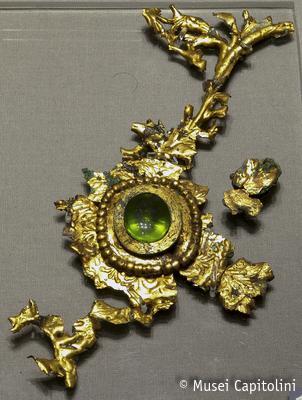


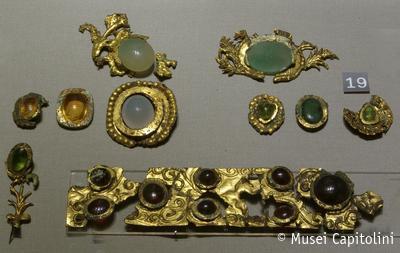
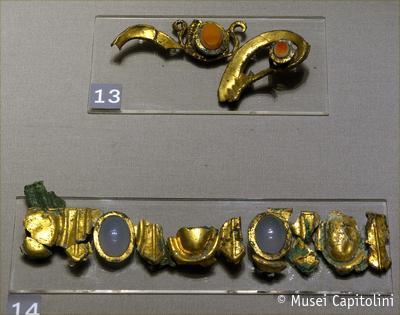

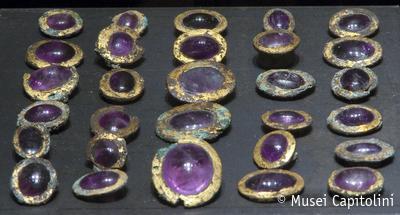

Gold and gemstone ornaments from the Horti Lamiani.
The Horti Lamiani (Lamian Gardens) were a set of gardens located atop the Esquiline Hill in Rome, in the area around the present Piazza Vittorio Emanuele. They were based on the gardens of the consul Lucius Aelius Lamia, a friend of Tiberius, and the Horti Lamiani soon (based on the time of Caligula) became part of the imperial property.
The land where the gardens were located, located outside the Servian Wall, was purchased by Lucius Aelius Lamia, the Roman consul in 3 CE and friend of Tiberius, who developed the initial gardens on the land. Upon the deaths of Tiberius and Caligula, who developed the property, the gardens became imperial property and Caligula was briefly buried at the site. The Horti Lamiani adjoined the Gardens of Maecenas and the Gardens of Maiani.
The first excavations took place in the sixteenth century and finds such as a copies of the Discobolus and Nozze Aldobrandiniwere unearthed, many of which are now located in museums. Rodolfo Lanciani began excavations in the area in the nineteenth century but his work was not completed. The immense building complex of the Horti Lamiani was brought to light in these excavations but was quickly re-buried. Decorations of the complex included frescoes, architectural elements in coloured marbles, and innumerable bronze sheets with inset gemstones. It has also produced important sculptural groups, like the well-known Esquiline Venus supported by two priests or Muses and the portrait of Commodus as Hercules bordered by tritons (both now in the Capitoline Museums collection). Between 2006 and 2009, excavations found previously undiscovered areas of the building complex of the Horti Lamiani. Other excavations took place during the construction of metro line A between January 2005 and November 2006.
517 notes
·
View notes
Text
Caligula’s Garden of Delights, Unearthed and Restored

The fourth of the 12 Caesars, Caligula — officially, Gaius Julius Caesar Germanicus — was a capricious, combustible first-century populist remembered, perhaps unfairly, as the empire’s most tyrannical ruler. As reported by Suetonius, the Michael Wolff of ancient Rome, he never forgot a slight, slept only a few hours a night and married several times, lastly to a woman named Milonia.
During the four years that Caligula occupied the Roman throne, his favorite hideaway was an imperial pleasure garden called Horti Lamiani, the Mar-a-Lago of its day. The vast residential compound spread out on the Esquiline Hill, one of the seven hills on which the city was originally built, in the area around the current Piazza Vittorio Emanuele II.
There, just on the edge of the city, villas, shrines and banquet halls were set in carefully constructed “natural” landscapes. An early version of a wildlife park, the Horti Lamiani featured orchards, fountains, terraces, a bath house adorned with precious colored marble from all over the Mediterranean, and exotic animals, some of which were used, as in the Colosseum, for private circus games.
When Caligula was assassinated in his palace on the Palatine Hill in 41 A.D., his body was carried to the Horti Lamiani, where he was cremated and hastily buried before being moved to the Mausoleum of Augustus on the Campus Martius, north of the Capitoline Hill. According to Suetonius, the elite garden was haunted by Caligula’s ghost.
Historians have long believed that the remains of the lavish houses and parkland would never be recovered. But this spring, Italy’s Ministry of Cultural Heritage, Cultural Activities and Tourism will open the Nymphaeum Museum of Piazza Vittorio, a subterranean gallery that will showcase a section of the imperial garden that was unearthed during an excavation from 2006 to 2015. The dig, carried out beneath the rubble of a condemned 19th-century apartment complex, yielded gems, coins, ceramics, jewelry, pottery, cameo glass, a theater mask, seeds of plants such as citron, apricot and acacia that had been imported from Asia, and bones of peacocks, deer, lions, bears and ostriches.
“The ruins tell extraordinary stories, starting with the animals,” said Mirella Serlorenzi, the culture ministry’s director of excavations. “It is not hard to imagine animals, some caged and some running wild, in this enchanted setting.” The science of antiquities department of the Sapienza University of Rome collaborated on the project.
The objects and structural remnants on display in the museum paint a vivid picture of wealth, power and opulence. Among the stunning examples of ancient Roman artistry are elaborate mosaics and frescoes, a marble staircase, capitals of colored marble and limestone, and an imperial guard’s bronze brooch inset with gold and mother-of-pearl. “All the most refined objects and art produced in the Imperial Age turned up,” Dr. Serlorenzi said.
The classicist Daisy Dunn said the finds were even more extravagant than scholars had anticipated. “The frescoes are incredibly ornate and of a very high decorative standard,” noted Dr. Dunn, whose book “In The Shadow of Vesuvius” is a dual biography of Pliny the Elder — a contemporary of Caligula’s — and his nephew Pliny the Younger. “Given the descriptions of Caligula’s licentious lifestyle and appetite for luxury, we might have expected the designs to be quite gauche.”
The Horti Lamiani were commissioned by Lucius Aelius Lamia, a wealthy senator and consul who bequeathed his property to the emperor, most likely during the reign of his friend Tiberius from A.D. 14 to 37. When Caligula succeeded him — it is rumored that Caligula and the Praetorian Guard prefect Macro hastened the death of Tiberius by smothering him with a pillow — he moved into the main house.
In an evocative eyewitness account, the philosopher Philo, who visited the estate in A.D. 40 on behalf of the Jews of Alexandria, and his fellow emissaries had to trail behind Caligula as he inspected the sumptuous residences “examining the men’s rooms and the women’s rooms … and giving orders to make them more costly.” The emperor, wrote Philo, “ordered the windows to be filled up with transparent stones resembling white crystal that do not hinder the light, but which keep out the wind and the heat of the sun.”
Evidence suggests that after Caligula’s violent death — he was hacked to bits by his bodyguards — the house and garden survived at least until the Severan dynasty, which ruled from A.D. 193 to 235. By the fourth century, the gardens had apparently fallen into desuetude, and statuary in the abandoned pavilions was broken into pieces to build the foundations of a series of spas. The statues were not discovered until 1874, three years after Rome was made the capital of the newly unified Kingdom of Italy. With the Esquiline Hill in the midst of a building boom, the Italian archaeologist Rodolfo Lanciani nosed around freshly excavated construction sites and uncovered an immense gallery with an alabaster floor and fluted columns of giallo antico, considered the finest of the yellow marbles.
He later stumbled upon a rich deposit of classical sculptures that, at some point in the horti’s history, had been deliberately hidden to protect them. The treasures included the Lancellotti Discobolus, now housed at the National Museum of Rome; the Esquiline Venus and a bust of Commodus depicted as Hercules, now at the Capitoline Museums. In short time, the sculptures were carted off, the foundation of an apartment building was laid, and the ancient ruins were reburied.
The latest excavation of the horti unfolded under the detritus of the residences, which had been evacuated in the 1970s in the wake of a building collapse. Much like the 2012 exhumation of Richard III in Leicester, England, the unburying involved a modern parking site.
Sixteen years ago, the three-and-a-half-acre property was purchased by Enpam, a private foundation that manages pensions for Italian doctors and dentists. Exploratory core drilling for a new headquarters and a six-level underground garage brought forth a wealth of first-century relics, from the type of window glass described by Philo to lead pipes stamped with the name of Claudius, Caligula’s uncle and successor.
As construction crews erected the five-story office building, archaeologists in a trench 18 feet below street level gingerly screened and scraped away soil. In a study lab across town, paleobotanists and archaeozoologists analyzed fragments, and researchers painstakingly repaired a 10-foot-high wall fresco painted with pigment made from ground cinnabar. The entire $3.5 million conservation and restoration project was underwritten by Enpam.
Ground was broken for the Nymphaeum Museum in 2017. “The new space, in the basement of Enpam, brings to light one of the mythical places of the empire’s capital, one of the garden residences loved by the emperors,” said Daniela Porro, the museum director.
What all of this does for Caligula’s seemingly irredeemable reputation is an open question. He emerges from Suetonius’s “The Twelve Caesars,” written 80 years after the emperor was bumped off, as utterly depraved: having incestuous relationships with his sisters, sleeping with anyone he liked the look of, using criminals as food for his wild beasts when beef became too pricey and insisting that a loyal subject who had vowed to give his own life if the emperor survived an illness should carry through on his promise and die.
Mary Beard, a professor of classics at Cambridge University, posited that while Caligula might have been assassinated because he was a monster, it is equally possible that he was made into a monster because he was assassinated. In “SPQR,” her rich history of ancient Rome, she argues that “it is hard to resist the conclusion that, whatever kernel of truth they might have, the stories told about him are an inextricable mixture of fact, exaggeration, willful misinterpretation and outright invention — largely constructed after his death, and largely for the benefit of the new emperor, Claudius.”
Whether Caligula got a raw deal from history is a subject of hot and unyielding debate. “There is clearly some bias in the sources,” Dr. Dunn allowed. “But even without that, it is difficult to envision him as a good emperor. I doubt these new discoveries will do much to rehabilitate his character. But they should open up new vistas onto his world, and reveal it to be every bit as paradisiacal as he desired it to be.”
from Multiple Service Listing https://ift.tt/3bDBxNi
1 note
·
View note